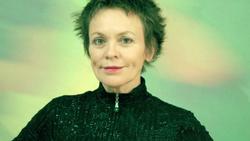A&E
Laurie Anderson dazzles in a multi-media music performance
By Gabe Skoletsky ’17
April 17, 2015
Laurie Anderson displayed her unprecedented originality on the Wellin Hall stage on April 11 in a performance that she called, “The Language of the Future.” Many recognize Ms. Anderson as a singer, violinist and visual artist, but this weekend, her most prominent role was that of a storyteller. Her stories, electronics, visualizations and personality all collaborated to create a one-woman show that defied all presumptions about a musician’s creative spectrum. Overall, the performance was engaging, beautiful and entrancing.
Upon entering the newly transformed stage of Wellin Hall, the atmosphere Ms. Anderson constructed was captivating. An assortment of lit candles littered the stage in random formations. On stage right, there was a simple armchair that contained only two microphones, while the stage left side contained an electrical contraption of all the digital musical devices she needed for her performance. The changing colors of the lighting and the backdrop created a distinctive mood for each story Ms. Anderson told. There was an element of precision with the words and the art. Many times during the performance, Ms. Anderson said words such as “green river,” and the stage would instantly turn green. There was an overall fascinating visual connection to the music and words that predominated the performance. Her focus on constructing a complex multimedia experience resulted in stimulating senses not only within the sonic spectrum, but also among the visual ones.
Ms. Anderson’s stories usually fell within the category of the completely absurd to the slightly believable. Topics ranged from breaking her back as child while diving into a pool to hitchhiking to the North Pole. Most of these stories appeared to be characteristics of her own personality, but at other times, she seemed to become a new person. This sense of multiple stage personas was most apparent during the latter part of the show when she used a filter that dramatically lowered the frequency at which she spoke to create a slightly more philosophical counterpart. Ms. Anderson’s alter ego perhaps offered some of the most interesting commentary of the evening as he or she delved into the mysterious questions on the human construction of time and expectations for the future.
Throughout the stories, the music often remained as minimal as possible. It did not seem that the music was the integral component to the overall scheme of the show, only an accompanying factor that contributed to Ms. Anderson’s personal expressiveness. The dominance of narrative over an elaborate musical performance represented a clear intention of innovative communication. The diverse content of these stories begged the question, was the person on the stage the real or fictitious Laurie Anderson? To this question she simply responds: “I suppose I have an interview self and a hang-out-with-my-friends self, but I suppose they’re both not that different.”
While the music, with the exception of her solo violin playing, tended to remain minimal, Ms. Anderson’s experimentation with, and coordination of, electronics represented the most diverse arsenal of her artistic creativity. The electric violin powerfully expressed many of the unique sounds she used throughout the show. The violin often looped a faster passage over a much simpler one. The simpler passages were rich in overtones that vibrated throughout the air. Ms. Anderson’s creation and control of these electronic components were perhaps the most impressive aspects of the performance. “I am running a combination of Max, Ableton, and a combination of my own software,” said Ms. Anderson, “all controlled from my iPad.” At the concert’s end, it did not appear that musical virtuosity was Ms. Anderson’s greatest strength or intention, but rather how she captivated her audience with effectively orchestrated sound design.
Although after the show, Ms. Anderson did not feel that she could effectively express her intended meaning behind the language of the future concept, as an audience member, the title seemed a little less ambiguous. It initially seemed fairly ironic that a performer whose intention is direct communication only uses technology to achieve that direct communication, because although technology has the ability to connect people, it also has a tendency of causing social disconnect. However, perhaps a language of the future would create a symbiotic relationship between communication and technology. If that is the case, Ms. Anderson’s use of technology perfectly suits the criteria for a language of the future. In this performance, the combination of words, art and music synthesized to create a unique form communication that a mind like Laurie Anderson’s could effectively execute.





